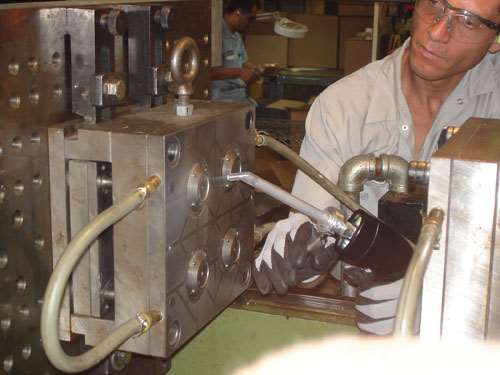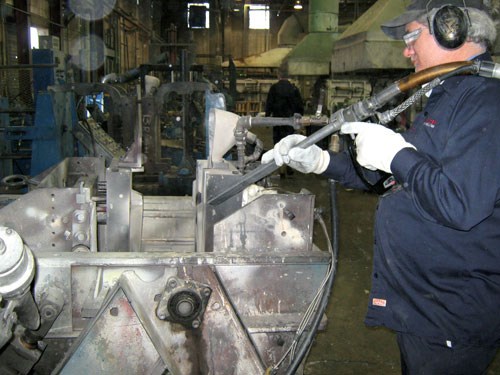Dry Ice Blast Cleaning-It’s A Portable And Safe Alternative
With the economy slowing, manufacturers are looking to get the most out of everything in their plants, from current staff levels to production equipment. They are evaluating all people and processes in an effort to incorporate lean manufacturing principles, which focus on eliminating waste, streamlining production,
With the economy slowing, manufacturers are looking to get the most out of everything in their plants, from current staff levels to production equipment. They are evaluating all people and processes in an effort to incorporate lean manufacturing principles, which focus on eliminating waste, streamlining production, improving quality and reducing costs. One process that impacts each of these areas is cleaning.
Production equipment has to be cleaned to ensure the quality of the end product. In many cases, cleaning processes require that production comes to a halt as machines are shut down and cooled, followed by a team of people that disassemble the equipment, transport it to a contained environment, clean it, dry it, and then reassemble and reheat it so that it is ready for the next shift. This type of cleaning process is common in a variety of industries, from large automotive plants to precision cleanroom environments. In many instances, this cleaning process can take several hours, if not a full shift to complete.
Featured Content
In addition, any time equipment is disassembled and moved, it is at risk of being damaged. The alternative is cleaning the equipment by hand while it is still online. Unfortunately, this adds additional production downtime because equipment needs to be cooled down before cleaning to avoid putting people at risk, as the equipment can be extremely hot. Another issue is that common industrial cleaning solvents used to clean the equipment can be toxic.
Therefore, one of the biggest challenges for manufacturers is finding a safe, cost-effective, efficient and user-friendly cleaning process. One process that is becoming increasingly popular is dry ice blast cleaning, which is capable of removing heavy weld slag, as well as cleaning delicate semiconductor circuit boards.
The process uses dry ice, a solid form of carbon dioxide (CO2), which is colorless, tasteless and odorless and is found naturally in the atmosphere. The grade of CO2 used in the dry ice blasting process varies by industry, but is equal to or greater than the dry ice used in the food and beverage industry. The cleaning process has been approved by the Food and Drug Administration, Environmental Protection Agency and United States Department of Agriculture.
Dry ice blast cleaning is similar in concept to sand blasting and soda blasting, where the respective media are accelerated in a pressurized airstream. However, unlike these blasting systems, dry ice blast cleaning is non-abrasive and can be regulated for use on hard or delicate surfaces. Dry ice blast cleaning works by accelerating recycled CO2 in the form of solid dry ice particles through a hose and high-velocity nozzle to create micro-explosions upon the surface to be cleaned. Because CO2particles have a temperature of -109°F, the combination of the kinetic and thermal shock effects of dry ice blasting breaks the bond between the surface and the residue, which is blasted away and easily removed. The dry ice particles vaporize into a gas upon impact.
There are several advantages of dry ice blast cleaning. In many circumstances, when using dry ice blast cleaning in industrial plants, the cleaning time is reduced by 75 to 90 percent by allowing companies to clean the equipment while it is hot and online. Cleaning costs can also be reduced as one person with one dry ice blast cleaning machine can clean equipment significantly faster than a typical crew of four cleaning equipment by hand. In addition, dry ice is relatively inexpensive and easy to store. Dry ice blast cleaning systems, such as those developed by Cold Jet, have hoppers with added insulation so you can keep the dry ice fresh for longer periods of time or use the tilt-out hopper feature to easily remove dry ice when the job is complete, storing it back in the ice tote until needed for the next job.
Dry ice blast cleaning is a dry process and does not produce a by-product like sand or soda blasting. As a result, there is no secondary waste treatment and disposal, and companies can quickly get the equipment ready for additional production cycles.
Since dry ice blast cleaning is a dry process, it does not wet the surface, and there is no downtime waiting for the cleaned surface to dry. Unlike steam cleaning or water blasting, dry ice blast cleaning systems are safe to use on electrical wiring and other sensitive equipment. In addition, because CO2is a gas, it does not encourage the formation of rust or bacteria growth, which is a concern when using liquid-based cleaning processes.
Dry ice blast cleaning systems are also environmentally friendly. There are three core environmental benefits of dry ice blast cleaning.
First, this type of cleaning helps reduce the dependency on water in conventional cleaning processes. The waste removed from equipment can be vacuumed, reducing the possibility of waste-stream contamination.
The process is also safe and non-toxic and does not release harmful gases into the atmosphere. By using recycled CO2 for its cleaning process, it is making productive use of otherwise nonproductive CO2.
Dry ice blast cleaning also helps eliminate the need for any ozone-depleting chemicals and solvents commonly used in industrial cleaning, restoration and remediation processes.
It can be used for virtually any manufacturing environment from cleaning machinery that cannot be moved or that is too complex to be taken apart, to cleaning machining tools, dies, molds and equipment. Cold Jet’s systems have also been used to clean radioactive waste facilities, electric motors, printing presses and fire damaged buildings.
In the right applications, the dry ice blast cleaning process can be faster, safer, more efficient and environmentally friendly than many other cleaning methods. Dry ice blasting allows manufacturers to clean their equipment and facilities better in a shorter period of time, with fewer resources.
By replacing conventional cleaning methods with dry ice blast cleaning, companies can help to strengthen their lean and green manufacturing initiatives and maximize their resources in a difficult economic environment. This process is helping companies around the world improve their internal maintenance processes and focus more time and effort on productivity and quality, while increasing efficiency and reducing waste.
RELATED CONTENT
-
The Importance of Drying Parts After Cleaning
Most cleaning processes consist of three steps, not two: wash, rinse and dry. That drying step is absolutely necessary for everything from product finishing to product performance to effective throughput to product quality.
-
Cleanliness Compliance is Critical for Automotive Suppliers
Although not every shop has been affected by cleanliness specifications, many suppliers to automotive OEMs are already complying with stringent cleanliness standards. In Ford Motor Co.’s case, it has created its own cleanliness standards in order to save money and credibility.
-
Ultrasonic Cleaning Basics: Technology, Solvents and Advantages
Ultrasonic cleaning technology is explained here as well as how to choose a type of ultrasonic machine for an application, the kind of detergent to use, and the advantages of using this parts cleaning method.







